
Benefits of the Inclusion Model
A lot of school districts, for a variety of reasons, are beginning to adopt an inclusion model for special education. For more about inclusion, check out A Beginners Guide to Inclusion. Inclusion can present a variety of difficulties for the staff members involved. Having to constantly adjust curriculum to the wide varieties of needs and abilities in your classroom is a challenge. But, when done right, inclusion is definitely worth the work.
Rigorous Curriculum
When you include students with disabilities in the general education classroom, they are still being exposed to all of the grade level curriculum that their peers are. The students are exposed to positive peer role models who can help keep the bar high for all students and encourage students with disabilities to strive to do their best.
Social Inclusion
When students are not included in the general education classroom, they are kept separate from their peers. Only being around their peers during specials and lunch is not going to give them time to create relationships. This can really hurt the self-confidence of students with disabilities. As they get older and realize that they are different and separated from their peers, they could begin to feel bad about their self-worth and intelligence.
Reduced Stigma
When students are fully included in the general education classroom, it becomes difficult to tell which students have disabilities. As students get older, I see this a lot in middle school, they start to become more aware of what their peers are doing. They notice which students participate in small group lessons or classes.
Following the inclusion model allows all students to be included in the classroom, preventing the general education peers from being able to easily identify which students have disabilities or struggle in class. This will hopefully prevent some issues that may arise.
Also, Check Out:
Tips for a New Inclusion Teacher
Guiding Successful Paraprofessionals
FREE co-teaching checklist

Subscribe to receive a free co-teaching checklist!







